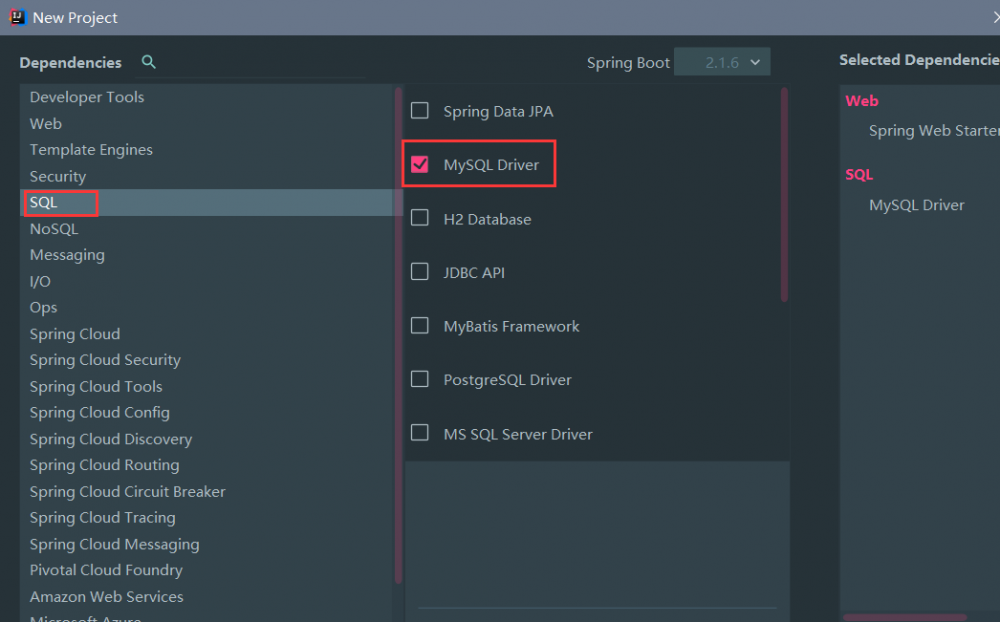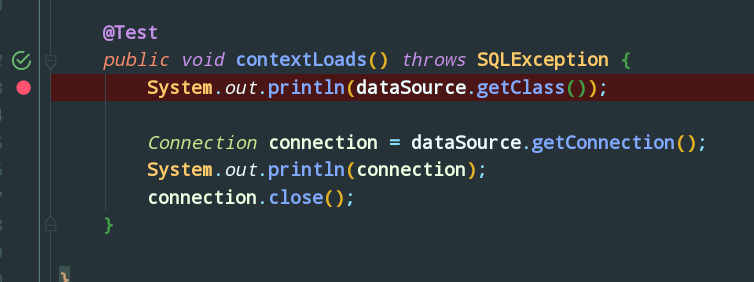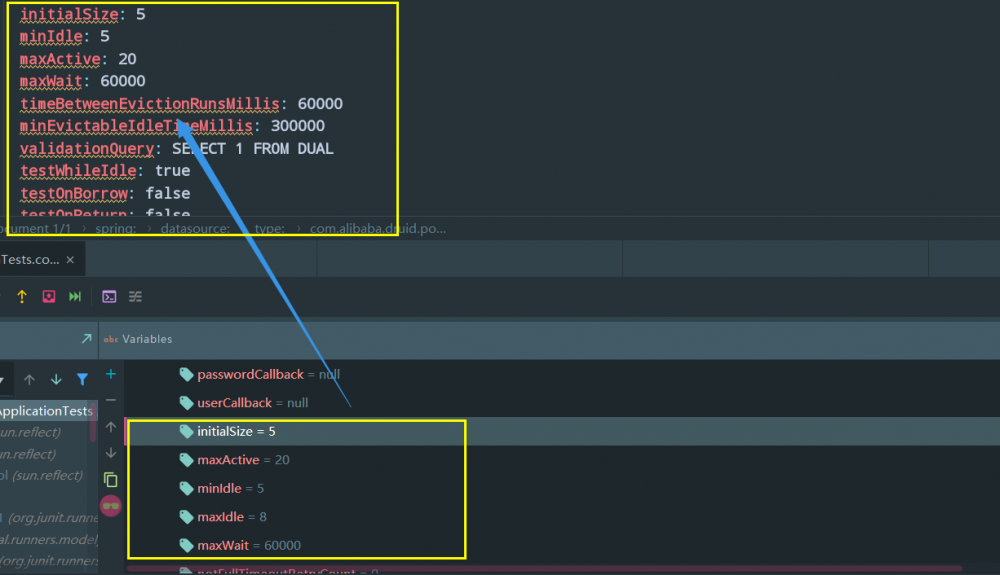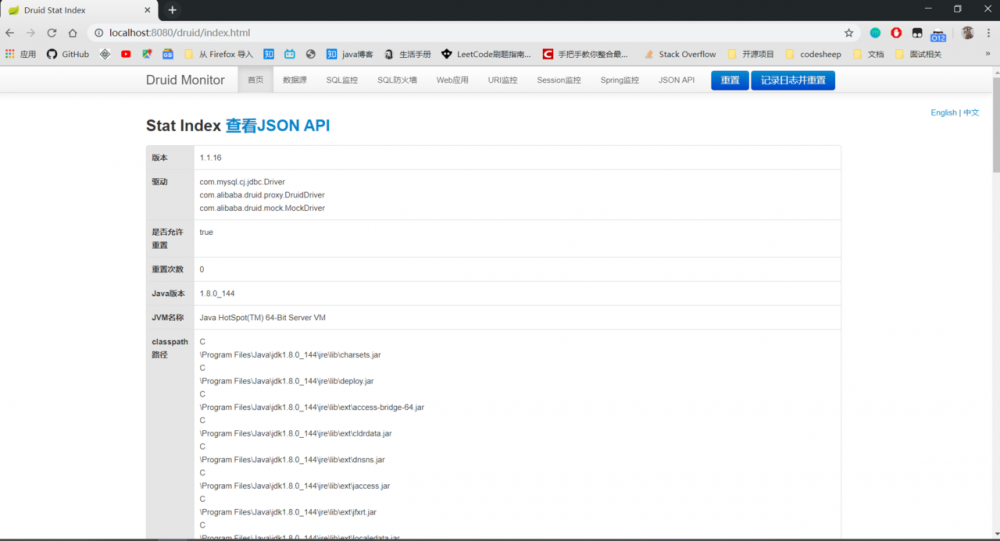Spring Boot数据访问-整合Druid数据源&Druid监控
-
idea 2019.1
-
maven
-
Spring Boot 2.1.5
-
jdk 1.8
-
Win 10
...
主要依赖
使用 idea 自动化创建Spring Boot项目,这里不再赘述了, 不过需要注意的是, 我们需要把Mysql驱动勾选上:

需要其他依赖, 可以自己勾选;
完整的pom文件:
<?xml version="1.0" encoding="UTF-8"?>
<project xmlns="http://maven.apache.org/POM/4.0.0" xmlns:xsi="http://www.w3.org/2001/XMLSchema-instance"
xsi:schemaLocation="http://maven.apache.org/POM/4.0.0 http://maven.apache.org/xsd/maven-4.0.0.xsd">
<modelVersion>4.0.0</modelVersion>
<parent>
<groupId>org.springframework.boot</groupId>
<artifactId>spring-boot-starter-parent</artifactId>
<version>2.1.5.RELEASE</version>
<relativePath/> <!-- lookup parent from repository -->
</parent>
<groupId>com.carson</groupId>
<artifactId>spring-boot-06-data-jdbc</artifactId>
<version>0.0.1-SNAPSHOT</version>
<name>spring-boot-06-data-jdbc</name>
<description>Demo project for Spring Boot</description>
<properties>
<java.version>1.8</java.version>
</properties>
<dependencies>
<dependency>
<groupId>org.springframework.boot</groupId>
<artifactId>spring-boot-starter-jdbc</artifactId>
</dependency>
<dependency>
<groupId>org.springframework.boot</groupId>
<artifactId>spring-boot-starter-web</artifactId>
</dependency>
<dependency>
<groupId>mysql</groupId>
<artifactId>mysql-connector-java</artifactId>
<scope>runtime</scope>
</dependency>
<dependency>
<groupId>org.springframework.boot</groupId>
<artifactId>spring-boot-starter-test</artifactId>
<scope>test</scope>
</dependency>
<dependency>
<groupId>log4j</groupId>
<artifactId>log4j</artifactId>
<version>1.2.17</version>
</dependency>
<dependency>
<groupId>com.alibaba</groupId>
<artifactId>druid</artifactId>
<version>1.1.16</version>
</dependency>
</dependencies>
<build>
<plugins>
<plugin>
<groupId>org.springframework.boot</groupId>
<artifactId>spring-boot-maven-plugin</artifactId>
</plugin>
</plugins>
</build>
</project>
复制代码
记得把 druid 连接池添加上, 并且加上 log4j 的依赖, 不加的话等下会报错
开始配置
然后我的配置文件选择 yml 后缀的:
spring:
datasource:
password: root
username: root
url: jdbc:mysql://localhost:3306/ssm?serverTimezone=UTC
driver-class-name: com.mysql.cj.jdbc.Driver
# 指定连接池类型
type: com.alibaba.druid.pool.DruidDataSource
# ------------分割线---------------------------
# 这下面的东西先不要添加到你的配置文件里,因为不会生效
initialSize: 5
minIdle: 5
maxActive: 20
maxWait: 60000
timeBetweenEvictionRunsMillis: 60000
minEvictableIdleTimeMillis: 300000
validationQuery: SELECT 1 FROM DUAL
testWhileIdle: true
testOnBorrow: false
testOnReturn: false
poolPreparedStatements: true
# 配置监控统计拦截的filters,去掉后监控界面sql无法统计,'wall'用于防火墙
filters: stat,wall,log4j
maxPoolPreparedStatementPerConnectionSize: 20
useGlobalDataSourceStat: true
connectionProperties: druid.stat.mergeSql=true;druid.stat.slowSqlMillis=500
复制代码
从分割线以下的配置,是不会生效的, 所以我们等下需要特殊配置一下,
不过让我们先测试一下我们的连接池 是否为 Druid 连接池,
打开我们test包下的测试类, 我这里放上我的完整代码:
package com.carson.springboot;
import org.junit.Test;
import org.junit.runner.RunWith;
import org.springframework.beans.factory.annotation.Autowired;
import org.springframework.boot.test.context.SpringBootTest;
import org.springframework.test.context.junit4.SpringRunner;
import javax.lang.model.element.VariableElement;
import javax.sql.DataSource;
import java.sql.Connection;
import java.sql.SQLException;
@RunWith(SpringRunner.class)
@SpringBootTest
public class SpringBoot06DataJdbcApplicationTests {
@Autowired
DataSource dataSource;
@Test
public void contextLoads() throws SQLException {
System.out.println(dataSource.getClass());
Connection connection = dataSource.getConnection();
System.out.println(connection);
connection.close();
}
}
复制代码
运行此测试你将会看到控制台输出的连接池类型:

正是我们需要的连接池类型
还记得刚才说的不生效的那些配置吗? 现在让我们来设置一下;
首先创建一个config配置类:
package com.carson.springboot.config;
import com.alibaba.druid.pool.DruidDataSource;
import org.springframework.boot.context.properties.ConfigurationProperties;
import org.springframework.context.annotation.Bean;
import org.springframework.context.annotation.Configuration;
import javax.sql.DataSource;
@Configuration
public class DruidConfig {
@ConfigurationProperties(prefix = "spring.datasource")
@Bean
public DataSource druid() {
return new DruidDataSource();
}
}
复制代码
@ConfigurationProperties: 前缀, 表示带这些前缀的配置生效
然后在测试类打个断点,debug运行一下:

结果:

可以看到属性是正确的
配置Druid监控
1) 配置一个管理后台的Servlet
依然是刚才的 DruidConfig 配置类,我们来添加以下方法:
@Bean
public ServletRegistrationBean statViewServlet() {
ServletRegistrationBean bean = new ServletRegistrationBean (new StatViewServlet(), "/druid/*");
Map<String, String> initParams = new HashMap<>();
// 账号,
initParams.put("loginUsername", "admin");
// 密码,
initParams.put("loginPassword", "123456");
// 允许登录的ip(为空 就是所有都允许)
initParams.put("allow", "");
// 然后是不允许的ip地址
initParams.put("deny", "192.123.11.11");
// 设置初始化参数
bean.setInitParameters(initParams);
return bean;
}
复制代码
这些参数是从哪里来的呢? 就是下面:

2)配置一个监控的 filter
// 2)配置一个监控的 filter
@Bean
public FilterRegistrationBean webStatFilter() {
FilterRegistrationBean bean = new FilterRegistrationBean();
bean.setFilter(new WebStatFilter());
Map<String, String> initParams = new HashMap<>();
// 不拦截那些属性
initParams.put("exclusions","*.js,*.css,/druid/*");
// 设置初始化参数
bean.setInitParameters(initParams);
// 默认拦截所有
bean.setUrlPatterns(Arrays.asList("/*"));
return bean;
}
复制代码
设置好这个,我们可以启动Spring Boot的主类, 然后访问 德鲁伊(Druid)监视器: http://localhost:8080/druid
这个路径是druid默认的路径, 你会看到一个登录页面:

密码就是我们刚才设置的 admin 和 123456
查看效果:

为了查看以下我们的 SQL监控 的效果, 我们来写一个 controller :
package com.carson.springboot.controller;
import org.springframework.beans.factory.annotation.Autowired;
import org.springframework.jdbc.core.JdbcTemplate;
import org.springframework.stereotype.Controller;
import org.springframework.web.bind.annotation.GetMapping;
import org.springframework.web.bind.annotation.ResponseBody;
import java.util.List;
import java.util.Map;
@Controller
public class HelloController {
@Autowired
JdbcTemplate jdbcTemplate;
@ResponseBody
@GetMapping
public Map<String, Object> map() {
List<Map<String, Object>> list = jdbcTemplate.queryForList("select * from user ");
return list.get(0);
}
}
复制代码
并且向网页发送 query 请求:

然后查看 SQL 监控:

END~~
正文到此结束
- 本文标签: 统计 map bug CTO tab schema js plugin IDE Statement java list pom core sql springboot 2019 代码 测试 Connection https bean 数据 JDBC spring XML maven src cat Spring Boot UTC NFV root dataSource ip Word UI 连接池 mysql Select 自动化 lib description id 管理 druid web dependencies servlet http 配置 HashMap App db build tar IO CSS junit apache 参数
- 版权声明: 本文为互联网转载文章,出处已在文章中说明(部分除外)。如果侵权,请联系本站长删除,谢谢。
- 本文海报: 生成海报一 生成海报二
热门推荐
相关文章
Loading...











![[HBLOG]公众号](https://www.liuhaihua.cn/img/qrcode_gzh.jpg)

